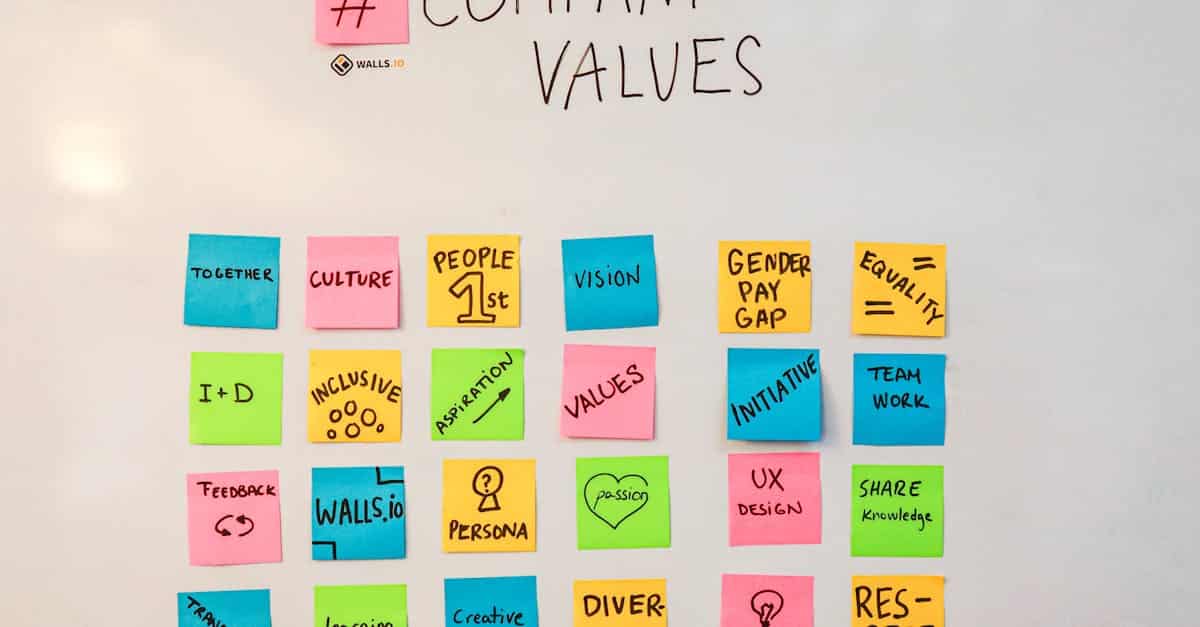Creating a cohesive and motivated team is essential to achieve ambitious goals. A shared vision gives a profound meaning to collective actions. Setting concrete goals reinforces each individual’s commitment within the group.
To successfully establish a positive dynamic, it is crucial to promote exchange and discussion within the team. By involving each member in the construction of the vision, collaboration and accountability are encouraged. Well-structured seminars can serve as a catalyst to align individual aspirations with collective goals. Using innovative and suitable tools maximizes participation and the effectiveness of meetings. Thus, each member feels valued and motivated to contribute fully. This educational approach facilitates the emergence of a strong and cohesive team spirit. Together, you will overcome challenges and celebrate successes enthusiastically.

Why developing a shared vision is essential for your team
In today’s professional world, developing a shared vision is more crucial than ever to ensure cohesion and performance in your team. A common vision allows each member to understand and fully commit to collective objectives. This not only fosters alignment of individual efforts but also creates a sense of belonging and collective responsibility. According to Davis Langdon, a well-defined vision can transform an ordinary team into a truly harmonious workforce.
How to create bonds within your team
Creating strong bonds within your team is the first step towards developing a shared vision. Team-building activities, seminars, or simply moments of conviviality can strengthen interpersonal relationships. A strong team spirit promotes open communication and mutual trust, which are essential for building a collective vision. During these moments, it is important to encourage exchanges and allow each member to express themselves freely, thereby contributing to better understanding and cooperation.
How to build an effective common vision
Building a common vision starts with clearly defining the team’s objectives and aspirations. This can take place during a dedicated seminar where all members actively participate. By collaborating, you can co-create the vision by taking into account everyone’s perspectives and ideas. Using innovative tools, such as Value Proposition Design, can help structure and clarify the team’s expectations, ensuring that the vision is shared and engaging for all.
What concrete goals to set with your team
Setting concrete goals is vital to give clear direction to your team. These goals should be specific, measurable, achievable, realistic, and time-bound (SMART). By involving the entire team in this process, you ensure deeper commitment and a better understanding of priorities. For example, defining where the team aspires to be in 12 months or in 2 years helps create a collective roadmap. Daniel Pink emphasizes that meaning, mastery, and autonomy are powerful motivators for motivation, and integrating these elements into your goals can significantly increase member engagement.
What tools to use to promote exchange and discussion
To promote exchange and discussion within the team, it is important to choose suitable tools. Techniques such as world café or icebreakers can encourage participation and the expression of ideas. These game-based animation tools stimulate collective intelligence and allow for generating innovative ideas. For example, using activities like the marshmallow challenge can help break the ice and establish an atmosphere of trust and creativity.
How to organize a seminar to build a shared vision
Organizing a seminar is an effective way to bring the team together and work on the shared vision. Here is an 8-step plan to successfully conduct this seminar:
- Icebreaker: Start with fun activities to relax the atmosphere and encourage interactions.
- Anti-problem: Allow members to express the difficulties encountered and what could be improved.
- Agile Framing: Organize the discussed points into categories for better organization of ideas.
- World Café: Generate concrete solution paths to improve the team’s functioning.
- Lunch break: Allow a break in a friendly setting to strengthen informal ties.
- Dynamic Relaunch: Use another icebreaker to re-energize the afternoon.
- Value Proposition Design: Work on defining what is important for the team and its future projects.
- Desired Future: Conclude with a short-term action plan to implement the generated ideas.
By following this schedule, you will effectively structure the day and maximize the results achieved.
What risks to avoid when building a shared vision
When building a shared vision, certain pitfalls can compromise the process. It is essential to truly engage in collaboration and co-construction. If you do not intend to pursue this path, team members may feel manipulated, leading to a loss of trust. Furthermore, it is crucial to take into account and utilize the ideas that emerge during the seminar. Ignoring members’ contributions can not only demotivate the team but also nullify the potential benefits of a shared vision.
Tips to ensure the effectiveness of your seminar
To ensure your seminar’s effectiveness, here are some practical tips:
- Own the itinerary: Test the tools during less important meetings and adapt them to your specific goals.
- Choose a suitable venue: A spacious, accessible, and pleasant environment enhances the well-being and focus of participants.
- Prepare necessary materials: Ensure you have all required materials, such as sticky notes, markers, and flip charts.
- Manage time: Respect the timing of each phase to avoid delays and maintain engagement.
- Plan follow-ups: Organize collective appointments post-seminar to consolidate ties and address potential difficulties.
These tips will help structure your seminar effectively and maximize positive interactions within the team.
How to maintain engagement and momentum after the seminar
Maintaining engagement and momentum after the seminar is essential for the shared vision to materialize. Once the seminar is over, it is important to follow up on the actions decided and continue strengthening ties within the team. Organizing co-development sessions or regular workshops can help maintain motivation and adjust goals as projects evolve. Additionally, celebrating interim successes helps sustain a positive atmosphere and recognize each person’s efforts.
What benefits to expect from a shared vision
Adopting a shared vision brings numerous benefits to the team and the entire organization. A clear and common vision allows for guiding collective actions towards a specific objective, thereby facilitating decision-making and coordinating efforts. It also enhances individual motivation, as each member feels involved in a meaningful project. Moreover, a shared vision promotes innovation by encouraging collaboration and the exchange of ideas. According to a recent study, teams with a common vision perform better and are more resilient in the face of challenges.
How to evaluate the impact of your shared vision
To evaluate the impact of your shared vision, it is important to establish appropriate performance indicators. These indicators can include measures of employee satisfaction, goal achievement rates, or assessments of team engagement and cohesion. By regularly collecting feedback, you can adjust and improve your vision based on returns and results obtained. Utilizing assessment tools, such as satisfaction surveys or individual interviews, allows you to measure the effectiveness of the shared vision and identify areas for improvement.
Examples of successful shared visions
Many companies have successfully developed a strong and inspiring shared vision. For example, Davis Langdon has created a vision that unites its collaborators around common and motivating goals. By involving all members of the team in the vision definition process, the company was able to enhance cohesion and improve overall performance. These examples illustrate the importance of collective involvement in creating a shared vision and the benefits organizations derive from it.
The mistakes to avoid when implementing a shared vision
To successfully develop a shared vision, it is essential to avoid certain common mistakes. One of the main errors is not to sufficiently involve the entire team in the vision definition process. A top-down imposed vision may lack legitimacy and fail to garner everyone’s support. Additionally, it is important not to neglect the follow-up and implementation of the decided actions. A vision, no matter how well-defined, cannot materialize without a clear action plan and ongoing involvement from all team members.
Additional resources for further exploring the topic
To delve deeper into developing a shared vision, numerous resources are available. You can consult specialized articles, participate in training in executive coaching, or read books on collective intelligence development. These resources can provide you with additional tools and new perspectives to enrich your practice and strengthen your team.
Integrate a shared vision to transform your team
Integrating a shared vision within your team is a process that requires time, commitment, and collaboration. However, the benefits in terms of cohesion, performance, and member satisfaction are substantial. By following the steps described and using appropriate tools, you can create a common vision that will guide your team toward success and collective flourishing. For more advice and personalized support, do not hesitate to contact a specialized executive coach.

“`html
Frequently Asked Questions
Q: Why is it important to develop a shared vision within the team?
A: Developing a shared vision gives meaning to collective action, aligns individual objectives, and strengthens team cohesion. It fosters a common direction and motivates each member to contribute to collective success.
Q: How to organize an effective seminar to build a common vision?
A: It is recommended to plan a half-day or full-day seminar, preferably outside the usual workplace. Use game-based animation tools, collaboration, and collective intelligence to encourage exchanges and creativity.
Q: What are the main objectives of a team vision seminar?
A: The three main objectives are: 1) To express problems and concerns, 2) To engage the entire team to visualize the common objectives and vision, and 3) To create bonds and reinforce interactions among team members.
Q: What steps to follow to co-construct the “why of the team”?
A: Follow these steps: start with an icebreaker, express problems with an anti-problem, synthesize points with an Agile framing, identify solutions during a world café, re-energize the dynamic with another icebreaker, define values with Value Proposition Design, develop a desired future, and finally celebrate successes.
Q: What tools can be used to promote collaboration and cohesion?
A: Tools such as the marshmallow challenge, photo language, banana challenge, world café, Value Proposition Design, team or project boxes, and Cover Stories are effective for stimulating collaboration, creativity, and strengthening team cohesion.
Q: What mistakes to avoid when organizing a collaborative seminar?
A: It is crucial to sincerely engage in the collaboration and co-construction process. Avoid neglecting emerging ideas, which can lead to a loss of trust. Also, ensure time is managed effectively and choose a suitable location.
Q: How to ensure follow-up after the seminar to maintain team engagement?
A: Plan additional collective appointments to consolidate ties and resolve difficulties. Launch co-development groups among team members and implement a short-term action plan to ensure the ideas discussed are executed.
Q: What are the benefits of a clear and ambitious shared vision?
A: A clear and ambitious vision engages team members, fosters intrinsic motivation by aligning meaning, mastery, and autonomy, and guides collective actions toward common objectives, thus enhancing team performance and growth.











